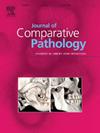Pathology of peritonitis in cattle
IF 0.8
4区 农林科学
Q4 PATHOLOGY
引用次数: 0
Abstract
Although peritonitis is highly prevalent in cattle, there have been only limited studies on the pathology of this condition. We describe the gross and histological aspects of primary and secondary peritonitis in cattle based on necropsy reports of 46 cases. Twenty-six were female (26/46; 56.5%) and 24 male (24/46; 43.5%), 31 (31/46; 67.4%) beef breed and 15 (15/46; 32.6%) dairy breed. Twenty were 0–12 months old (20/46; 43.5%), nine were 13–36 months old (9/46; 19.6%) and 15 were >36 months old (15/46; 32.6%). Two were of unknown age. Primary peritoneal tuberculosis (PT) was present in 7/46 cases (15.2%) and macroscopic lesions were mainly multifocal (6/7; 85.7%) and characterized by white to yellow, firm nodules of variable size. Histologically, they were characterized by granulomatous inflammation with intralesional acid–alcohol-resistant bacilli. All cases were positive for Mycobacterium tuberculosis complex and negative for Mycobacterium avium on immunohistochemistry. Secondary peritonitis was diagnosed in 39/46 cases (84.8%), caused by organ rupture or perforated ulcer (21/39; 53.9%), traumatic reticuloperitonitis (9/39; 23.1%), post-castration inflammation (7/39; 17.9%) or omphalophlebitis (2/39; 5.1%). Macroscopic lesions in secondary peritonitis were mainly diffuse (31/39; 79.5%) and comprised roughening of the peritoneal surface, which was covered by free white to yellow–orange fibrin strands with a liquid to pasty, opaque, white–grey effusion (30/39; 76.9%). Bacteriological culture of the exudate from 15 secondary peritonitis cases identified mainly Truperella pyogenes (8/15; 53.3%) and Escherichia coli (5/15; 33.3%). This study enhances our understanding of the pathological manifestations of peritonitis in cattle.
牛腹膜炎病理。
虽然腹膜炎在牛中非常普遍,但对这种情况的病理研究却很有限。我们描述了大体和组织学方面的原发性和继发性腹膜炎的牛基于尸检报告的46例。女性26例(26/46;56.5%),男性24人(24/46;43.5%), 31 (31/46;67.4%)牛肉品种和15 (15/46;32.6%)奶牛品种。0 ~ 12月龄20例(20/46;43.5%), 13 ~ 36月龄9例(9/46;19.6%), 16 ~ 36月龄15只(15/46;32.6%)。其中两人年龄不详。原发性腹膜结核(PT)占7/46例(15.2%),肉眼病变以多灶性为主(6/7;85.7%),特征为白色至黄色,大小不一的坚固结节。组织学上表现为肉芽肿性炎症,病灶内有耐酸醇杆菌。所有病例的结核分枝杆菌复合体免疫组化阳性,鸟分枝杆菌免疫组化阴性。继发性腹膜炎39/46例(84.8%),由脏器破裂或溃疡穿孔引起(21/39;53.9%),外伤性网状腹膜炎(9/39;23.1%),去势后炎症(7/39;17.9%)或脐静脉炎(2/39;5.1%)。继发性腹膜炎肉眼病变以弥漫性为主(31/39;79.5%),包括腹膜表面变粗,被游离的白色至黄橙色纤维蛋白束覆盖,呈液体至糊状,不透明,白灰色积液(30/39;76.9%)。15例继发性腹膜炎渗出液细菌学培养以化脓性Truperella为主(8/15;53.3%)和大肠杆菌(5/15;33.3%)。本研究提高了我们对牛腹膜炎病理表现的认识。
本文章由计算机程序翻译,如有差异,请以英文原文为准。
求助全文
约1分钟内获得全文
求助全文
来源期刊
CiteScore
1.60
自引率
0.00%
发文量
208
审稿时长
50 days
期刊介绍:
The Journal of Comparative Pathology is an International, English language, peer-reviewed journal which publishes full length articles, short papers and review articles of high scientific quality on all aspects of the pathology of the diseases of domesticated and other vertebrate animals.
Articles on human diseases are also included if they present features of special interest when viewed against the general background of vertebrate pathology.

 求助内容:
求助内容: 应助结果提醒方式:
应助结果提醒方式:


